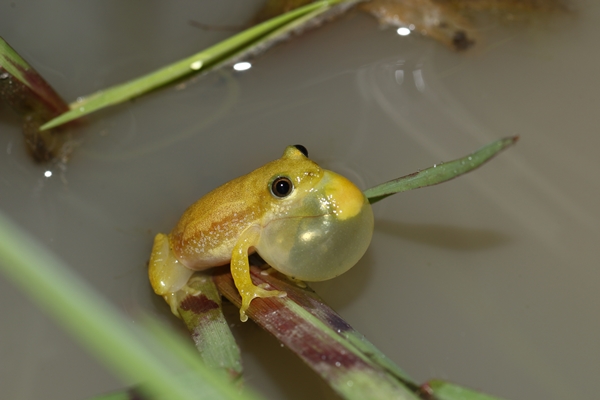View the above photo record (by Alison Sharp) in FrogMAP here.
Find the Golden Leaf-folding Frog in the FBIS database (Freshwater Biodiversity Information System) here.
Family Hyperoliidae
GOLDEN LEAF-FOLDING FROG – Afrixalus aureus
Pickersgill, 1984
Habitat
A. aureus is a savanna species which inhabits Coastal Bushveld-Grassland, a mosaic of vegetation types found from sea level to an altitude of 300 m along the coast of northern KwaZulu-Natal, as well as various other bushveld vegetation types, such as Mixed Lowveld Bushveld, at altitudes of 200–300 m, east of the eastern escarpment (Jacobsen 1989). Along the coast, it seems to prefer drier habitats than those occupied by A. delicatus and A. spinifrons and it does not usually utilize the same breeding sites as the latter species (Pickersgill 1984; M.P. pers. obs.).
Breeding takes place in seasonal or semi-permanent water bodies containing emergent vegetation such as Polygonum pulchrum, Ludwigia stolonifera and Cyperus papyrus (Backwell 1991). At most breeding sites the water is fairly shallow, rarely exceeding 50 cm in depth.
Behaviour
Nothing is known of the non-breeding behaviour of this species.
During the breeding season (November–February), adults can be found close to breeding sites at the margins of pans and grassy pools.

Photo by Vaughan Jessnitz
The frogs may sit on emergent vegetation, usually in leaf axils or on broad-leaved shrubs, fully exposed to the sun, in a head-down position. At dusk, males take up positions a few centimetres above the water, where they begin to call, continuing until about 04:00. High-density choruses develop; these contain a relatively high proportion (50%) of satellite males and are characterized by a high level of aggression (Backwell 1991). Within the choruses, males do not form small groups, as in A. spinifrons and A. delicatus.
Amplexus is axillary, and clutches of about 50 creamy white eggs are enveloped in vertically folded leaves (often of Polygonum pulchrum or Ludwigia stolonifera) or blades of grass, 4–15 cm above the surface of the water (Jacobsen 1989; Backwell 1991; Channing 2001).

Near Hoedspruit, Limpopo
Photo by Luke Verburgt
Status and Conservation
A. aureus is not considered to be threatened. Its habitat is used for stock and game farming, as well as ecotourism. It has been observed to breed in cattle waterholes, where vegetation is relatively sparse. It occurs in a number of provincial nature reserves, such as False Bay, Hluhluwe, Mkuze, Umfolozi, Nyalazi and Tembe, and in Kruger National Park.
Distribution
This species ranges northward into southern Mozambique (Pickersgill 1984; Poynton and Broadley 1987). Within the atlas region, A. aureusisa locally abundant species thatoccurs from the northeastern parts of the Limpopo Province, southward through eastern Mpumalanga, central and eastern Swaziland, to northern KwaZulu-Natal.
It is usually abundant at its breeding sites and easy to identify by its call. Although A. aureus and A. delicatus are morphologically similar, their calls are quite distinct and they usually use different breeding sites. The atlas data for A. aureus are reasonably complete and reliable.

Further Resources
Virtual Museum (FrogMAP > Search VM > By Scientific or Common Name)
More common names: Golden Spiny Reed Frog, Golden Dwarf Leaf-folding Frog, Goue Stekel-rietpaddatjie (Afrikaans), Goue Blaarvouendepadda (Afrikaans)
Recommended citation format for this species text:
Pickersgill M, Bishop PJ, Tippett RM. Golden Leaf-folding Frog Afrixalus aureus. BDI, Cape Town.
Available online at http://thebdi.org/2022/01/21/golden-leaf-folding-frog-afrixalus-aureus/
Recommended citation format:
This species text has been updated and expanded from the text in the
2004 frog atlas. The reference to the text and the book are as follows:
Pickersgill M, Bishop PJ 2004 Afrixalus aureus Golden Leaf-folding Frog. In Minter LR
et al 2004.
Minter LR, Burger M, Harrison JA, Braack HH, Bishop PJ, Kloepfer D (eds)
2004. Atlas and Red Data Book of the Frogs of South Africa, Lesotho and
Swaziland. Smithsonian Institution, Washington, and Avian Demography
Unit, Cape Town.

